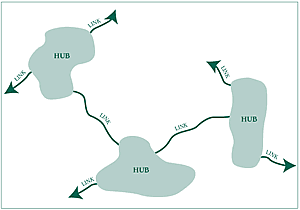Green Infrastructure
Local Example: Johnston County Natural Resource Initiative (JCNRI)
The Johnston County Natural Resource Initiative (JCNRI) is an effort to develop and promote strategies for the conservation of natural resources in the county. As part of the initiative the North Carolina Forest Service led an assessment process that produced a report highlighting the natural resources of the county. An executive summary focusing on key findings and suggested future county actions, as well as a brochure describing the initiative, were also produced.
What is Green Infrastructure?
We are going to define green infrastructure as an interconnected system of natural areas and other open spaces that are protected and managed for the ecological benefits they provide to people and the environment. It is the idea that trees and natural areas provide ecosystem function and value to sustain clean air and water, reduce soil erosion, provide wildlife habitat, and various other benefits to people.
Traditionally, when people think of infrastructure they think about roads, power lines, water systems, schools or hospitals. This is known as grey infrastructure; man-made improvements that support and improve human settlement. We understand that there has to be connectivity in order for this infrastructure to function successfully. The highways need to be connected to side streets in order for us to get from one place to another and utilities needs to be connected to areas of residence for people to have access to electricity and water. Green infrastructure is applying these same concepts of connectivity to trees and the natural system. It is a strategic approach to land conservation, addressing the economic and social impacts of sprawl and fragmented land.
Green space or open space is often thought of as isolated parks or recreational areas, it is viewed as self-sustaining and something "nice to have", or vacant land that is not yet developed. The concept of green infrastructure is that green space or open space must be connected and linked in order to function and provide the biggest benefit. Green infrastructure works under the idea of actively protecting, managing, or restoring natural areas to support life.
What does Green Infrastructure look like?
Green infrastructure can be managed at a number a different scales for a multitude of objectives; it is designed to be flexible and adjustable to the needs of current development. Green infrastructure systems can be:
- Protected watersheds that decrease the need for man-made water treatment facilities;
- Reforested slopes that help control flooding events and landslides;
- Protected waterways that prevent soil erosion, improve water quality, and provide wildlife habitat corridors;
- Planted swales or detention ponds that absorb and filter storm water run-off;
- Semi-porous paving stones that decrease direct storm water run-off from parking lots or;
- Private forest land that protects water quality, provides wildlife habitat, and increases ecosystem biodiversity.
Green infrastructure is a network of natural and restored native ecosystems and landscape features. This network is made up of hubs, links, and sites.

Hubs are large areas of land which serve as the anchor of the network. They are reserves such as state parks or wildlife refuges, managed landscapes such as state forests, and working lands such as private farms, forests and ranches.
Links range in size and function, depending on the land use, but they tie the whole system together, providing a connection between the hubs. Links can be conservation corridors, greenways, or ecobelts.
Sites are similar to hubs, but they are much smaller and localized. Some examples include community parks or arboretums.
What makes Green Infrastructure Different?
Green infrastructure understands that development and growth are inevitable and necessary, but the pattern of that growth, its location, form and intensity can be directed and managed to reduce negative impacts. It tries to work with development patterns and be integrated into upfront planning initiatives by identifying critical areas along with long range strategies to incorporate these lands into the natural system network. More importantly, proper green infrastructure systems lessen the need for expensive grey infrastructure installations.
Where does Urban Forestry fit in?
The benefits of trees are becoming better known. Trees provide clean air and water, provide shade which cools parking lots and buildings, mitigate storm water run-off effects, and increase real estate values. Urban forests help break up a landscape of impervious cover, provide small but essential green spaces, and link walkways and trails. When specific measures to protect and manage these areas are included, urban forests and trees can help reduce stormwater management needs in urban areas.
| Land Use | Approximate Annual Maintenance Costs | Source |
|---|---|---|
| Natural open space: Only minimal maintenance, trash/debris cleanup | $75 per acre per year | NPS, 1995 |
| Lawns: regular mowing | $270 to $240 per acre per year | WHEC, 1992 |
| Passive recreation | $200 per acre per year | NPS, 1995 |
Implementation Tools:
Green infrastructure requires active involvement in the planning process, but success of a green infrastructure plan relies heavily on implementation. Moving from the planning stage to on-the-ground results can make or break an initiative. Strategies need to be identified that are appropriate for a community's or organization's needs and capacity. What works for one community may not be appropriate in another due to citizen needs and concerns.
Potential tools for green infrastructure implementation include:
- Land acquisition - this includes fee-simple acquisition, conservation easements, purchase or transfer of development rights, community development block grants, Smart Growth initiatives.
- Regulation - the use of landscape ordinances, building permit regulations, mitigation banking, storm water regulations, zoning, comprehensive management planning, development impact fees.
- Incentives - management agreements, tax incentives, technical assistance, best management practices, recognition and award programs, and tax benefits.
- Funding - development fees, environmental impact fees, special assessment fees, open space protection bonds, transfer tax, transportation enhancement funds, and landowner incentives programs.